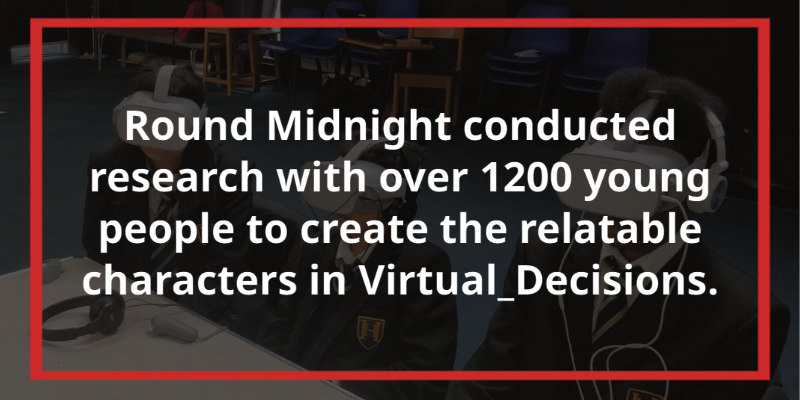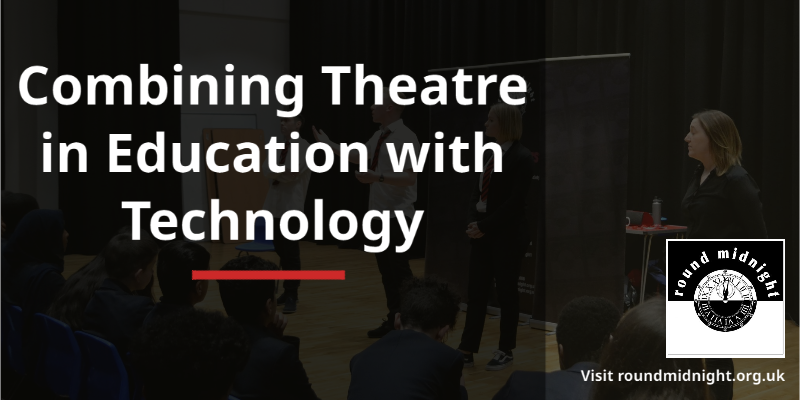At Round Midnight, we firmly believe that creativity and technology go together like bread and butter. Read on to learn how we have combined Theatre in Education creative practices with technology to enable immersive learning.
Debate around Creativity and Technology
Creativity and technology often seem distinct and separate entities. Some say that technology has destroyed creativity. Students can discover answers to questions at a touch of a button. Phones supposedly prevent students from engaging effectively with the world around them. However, at Round Midnight, we see the value in combining creativity and technology. Technology enhances creativity, allowing creativity to reach audiences throughout the world. Furthermore, technology provides a completely new way for students to digitally create and find creative solutions to everyday problems.
We have been using Theatre in Education (TIE) creative methodologies throughout the UK since 1992. However, we truly believe that creatives should not fear technology. Instead, we should actively consider ways technology can support our aims and objectives. Therefore, through programs such as Virtual_Decisions and LINK_UP, we blend creativity and technology to best engage and support young people. In this blog, we explore the core creative elements that make Theatre in Education performances so successful. We then demonstrate how we have blended TIE with digital innovation to provide a unique, cutting edge experience.
What is Theatre in Education?
Theatre in Education is a method whereby interactive creative practices are used to support the educational process. Traditionally, Theatre in Education combats key issues within society such as knife crime and sexual health by using creativity to open up important discussions with students. First pioneered by the Belgrade Theatre in Coventry in 1965, Theatre in Education adds value to educators because it provides a learning experience completely different from day to day classroom experiences.
Round Midnight Ltd have specialised in Theatre in Education for many years, developing live productions that facilitate open discussions about complex PSHE topics. We are proud of the unique way we encourage young people to investigate challenging situations for themselves. Recently, we have elevated our creative practices by combining Theatre in Education with immersive technology such as VR.
TIE Performances are Relatable
A successful Theatre in Education performance is compelling with real scenarios and characters. For instance, ‘Cutting Ties’ follows three friends, Aidan, Luke and Mia, who encounter difficulties in their friendship after the transition to Secondary School, and when Aidan falls in with the wrong crowd.
We successfully translated this TIE element of relatability to film with Virtual_Decisions, a VR experience exploring ideas of grooming and gang crime. We conducted research with over 1200 young people, to gauge what they deemed as risk-taking behaviour. Our scriptwriter, Phil Hyde, worked alongside Dr Stephanie Burnett-Heyes, a lecturer from the University of Birmingham with an expertise in adolescent behaviour. Together, they used in depth research to create the believable and relatable characters that are seen in Virtual_Decisions. The storylines and characters seen in Virtual_Decisions are heavily influenced by the young people spoken to during the research. This is why Virtual_Decisions has such an impact.

TIE encourages Participation and Decision Making
Theatre in Education practitioners often use ‘Forum Theatre’. This is a creative practice in which the fourth wall comes down, creating a space for audience participation. For example, actors freeze during a performance. Then, the facilitator asks the audience what they think the actors should do next to improve the situation. The actors then unfreeze and improvise the situation that has been put forward. This develops skills in decision making and problem solving. ‘Forum Theatre’ can be done throughout the performance until the audience are satisfied that they have achieved the best outcome for the characters.
Virtual_Decisions retains this focus on decision making. In Virtual_Decisions, each participant makes their own choices throughout the film, with each decision impacting the outcome of the film. This creates an opportunity for groups of participants to discuss their own unique journeys in the follow- on workshop.
Theatre in Education explores Alternate Viewpoints
TIE practitioners also explore a range of viewpoints. Particular actors can freeze and break the fourth wall to explain their own viewpoint and perspective. In Virtual_Decisions, there are preliminary discussions about each individual character, complete with detailed case studies. Then, in the follow up workshop, participants are encouraged to discuss these characters and how they reacted to different situations. This develops empathy and provides insight into a range of viewpoints. Creativity and technology work together to help young people gain a greater understanding of, not only themselves, but others.
TIE is a Safe Early Intervention Tool
Theatre in Education allows young people to see different scenarios played out in different ways. Through the use of Forum Theatre, participants are able to impact the outcome of the play. As such, TIE serves as an early intervention in which participants can learn from a simulated real life situation. However, this is done as a collective, with members of the audience inputting ideas to affect the outcome.
This is taken to the next level with Virtual_Decisions. Virtual_Decisions uses the same methodology of Theatre in Education. Participants can decide on the course of action, test out different paths and understand the consequences of each turn. However, instead of doing this as a group, participants do this as individuals. This creates a really unique experience in which the experience is even more tangible, but no less safe. Through technology, we can present a dangerous situation in a virtual world. This allows participants the opportunity to make mistakes and reflect upon them.
Theatre in Education opens a Space for Collaborative Discussion
Throughout our years working as Theatre in Education practitioners, we have ensured that stellar workshops and resources are available to elevate the impact of our creative practices. This is no different when we combine technology with creativity. Technology is often at its best when it provokes discussion. We use innovative technology to open up discussions in a follow-on collaborative workshop which involves reflection and dramatic techniques.
With Virtual_Decisions, it is these workshops that strengthen young people’s communication skills. The workshops encourage participants to speak up in a safe space about challenging PSHE topics. LINK_UP is even more collaborative. This new digital platform allows different classrooms and schools to reflect upon decisions together and collaboratively assess the different consequences. You can read more about LINK_UP here.
Theatre in Education is Engaging
In traditional Theatre in Education, the live performance element always makes an impression, helping young people to embrace key messages. Effective use of visuals and sound increases young people’s engagement and makes the experience highly memorable. By blending immersive technology such as VR with creative practices, we have maximised this element of Theatre in Education. When the experience is more tangible and interactive, participants can better understand the complexity of the situation. Read more about engagement in technology in education here.
The Practicality of Theatre in Education
The portability and practicality of Theatre in Education is a noteworthy aspect of the practice. In Theatre in Education, there are typically only a few actors per performance with the setting also kept minimal. Therefore, TIE practitioners can easily set up the performance arena in schools and transported around the country. With social distancing guidelines in place, we must consider the practicality of outside Theatre in Education performers visiting schools. At Round Midnight, we are currently in the research and development stage of LINK_UP, a digital platform which will allow our creative work with students to continue. Students will be able to experience Virtual_Decisions without practitioners being in the room. This ensures that safety is maintained and innovative approaches to the PSHE curriculum are available for both students and educators.
Round Midnight and the future of Theatre in Education
At Round Midnight, technology and creativity go hand in hand. We are excited to see where this combination of digital and drama takes us. If you would like to learn more about our projects, please contact us or learn more about PSHE through Tech here.

